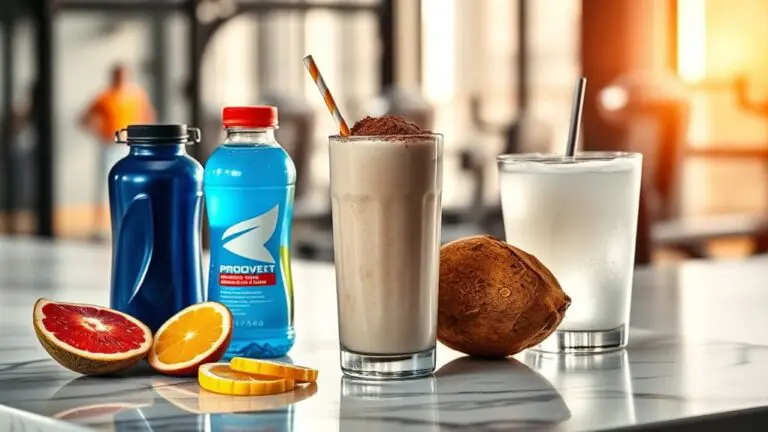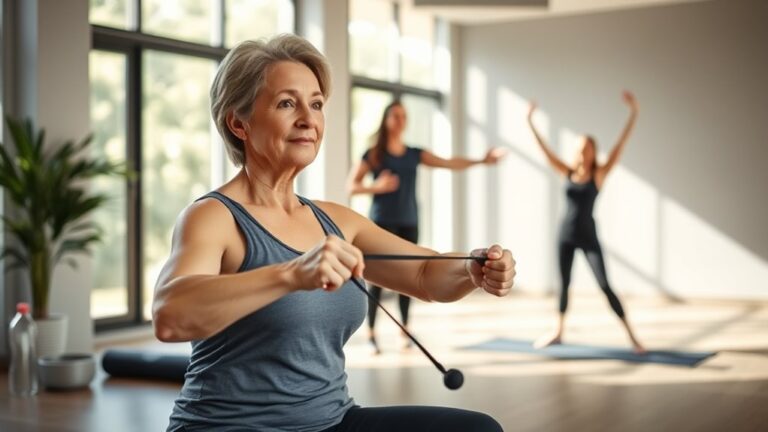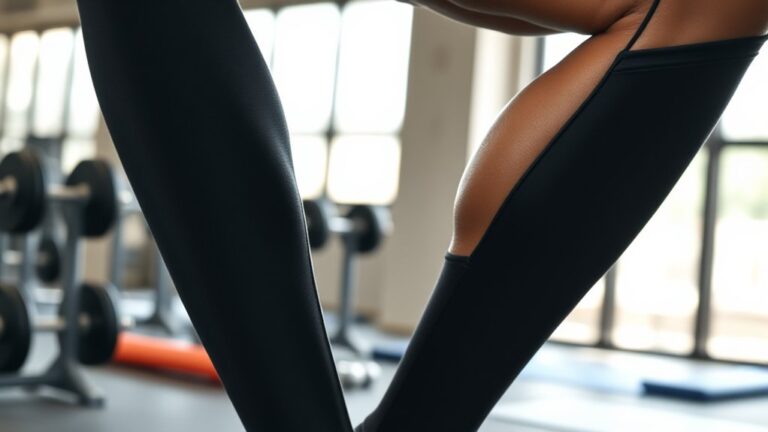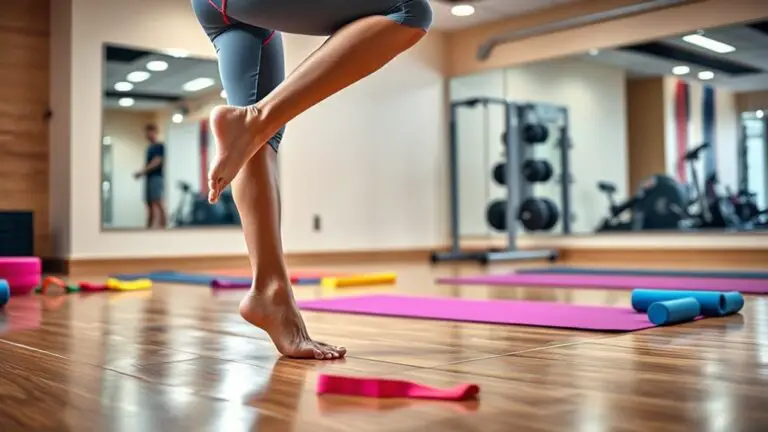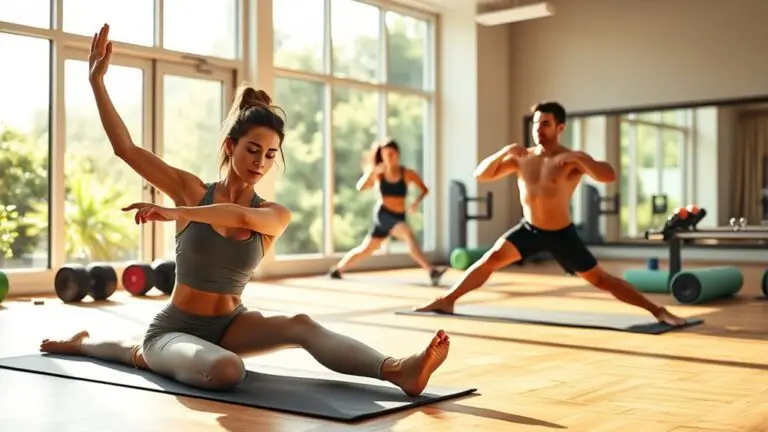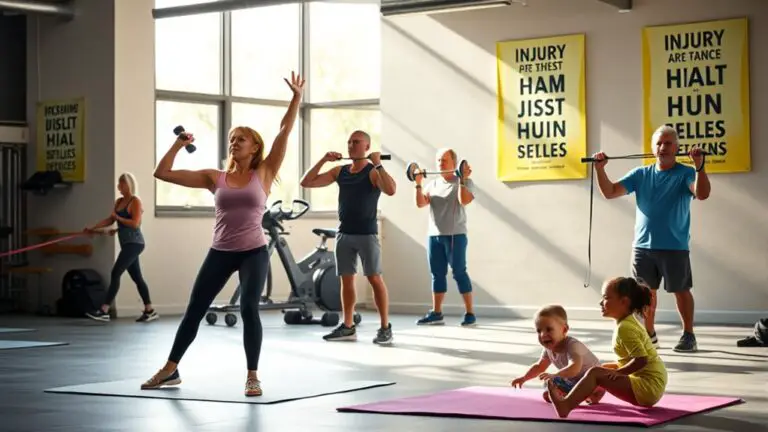How to Use Massage Guns for Post-Workout Relief
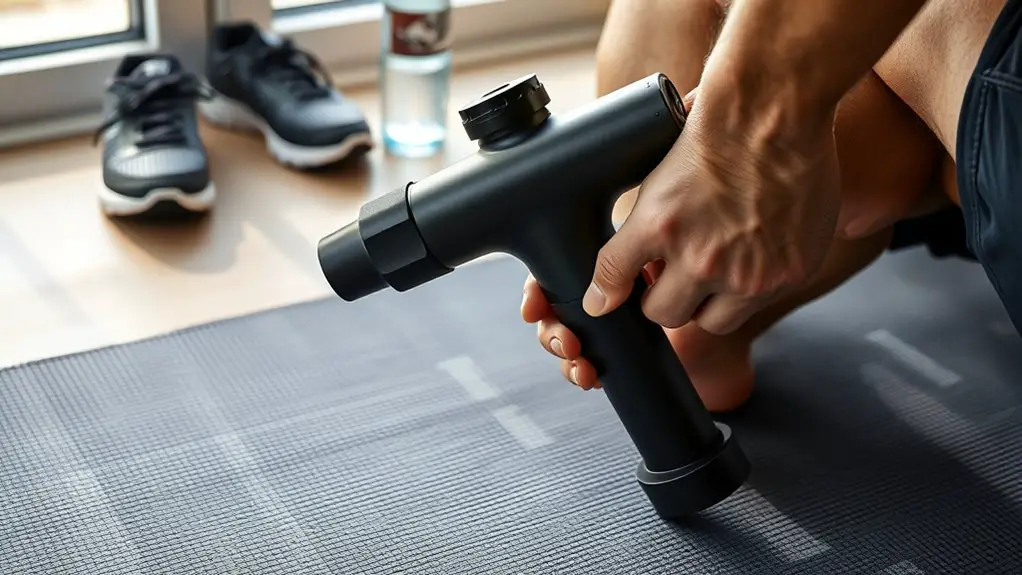
To use a massage gun for post-workout relief, start by targeting key muscle groups like your quadriceps, hamstrings, shoulders, and back. Hold the device at a 90-degree angle and begin with a low speed, gradually increasing intensity. Spend 1-2 minutes on each area, focusing on tight spots. Use it every other day to manage soreness, adjusting based on how your body feels. This routine can improve recovery times and flexibility. Stick around to discover more effective techniques!
Understanding the Benefits of Massage Guns
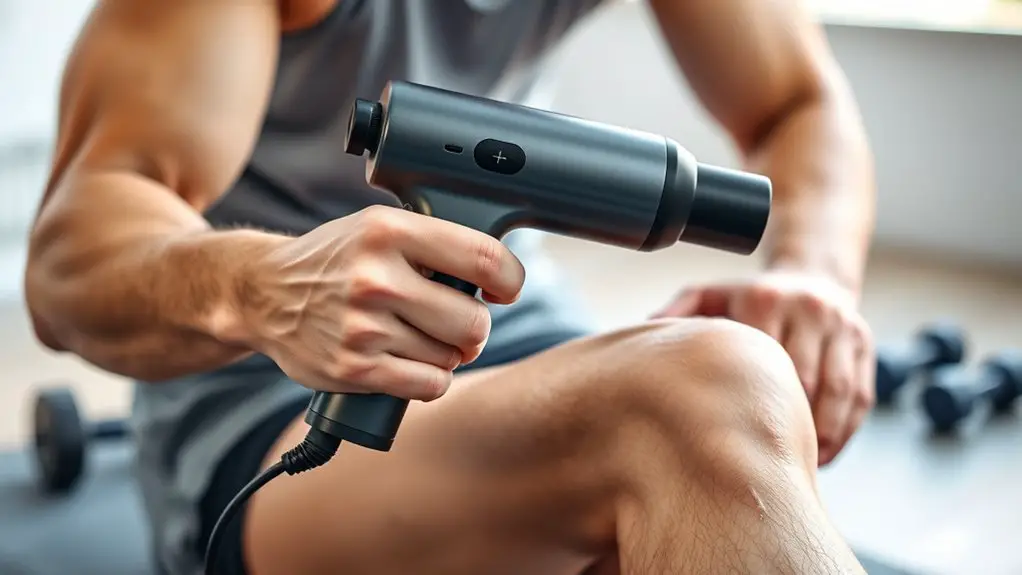
When you finish a tough workout, your muscles often need a little extra care to recover effectively. This is where massage guns come in. They’re designed to provide deep tissue massage, helping enhance muscle recovery by increasing blood flow and reducing soreness. Using a massage gun can greatly aid in pain relief, targeting specific areas that feel tight or achy after your workout.
Moreover, the percussive therapy offered by these devices can break down knots and improve flexibility, making it easier for your muscles to bounce back. You’ll find that just a few minutes with a massage gun can alleviate tension and speed up your recovery time, so you’re ready for your next session sooner. Plus, they’re easy to use and portable, allowing you to incorporate them into your post-workout routine seamlessly. Overall, investing in a massage gun can be a game-changer for your muscle recovery and overall performance.
Choosing the Right Massage Gun for Your Needs
When picking a massage gun, you’ll want to evaluate motor power and attachment options to suit your specific needs. A more powerful motor can deliver deeper pressure, while different attachments allow for targeted relief on various muscle groups. Understanding these features can help you find the perfect tool for post-workout recovery.
Motor Power Considerations
Choosing the right massage gun involves understanding its motor power, as this directly impacts the device’s effectiveness in delivering relief. When considering motor power ranges, you’ll find options that vary from lower to higher settings. A massage gun with a higher motor power can penetrate deeper into your muscles, providing enhanced relief and better recovery after intense workouts. The motor power benefits include increased blood circulation, reduced muscle soreness, and faster recovery times. If you’re an athlete or someone who frequently experiences muscle tension, opting for a model with robust motor power will likely be more beneficial. Assess your needs and choose a massage gun that aligns with your workout intensity and recovery goals for best results.
Attachment Variability Explained
Attachments play an essential role in maximizing the effectiveness of your massage gun. Understanding the different attachment types and their benefits can help you choose the right one for your needs. Here’s a quick reference guide:
| Attachment Type | Benefits |
|---|---|
| Flat | Great for large muscle groups |
| Round | Ideal for deeper tissue relief |
| Fork | Perfect for targeting spine areas |
| Bullet | Excellent for pinpoint pressure |
Selecting the right attachment can enhance recovery by addressing specific muscle groups or tension points. So, take a moment to reflect on your workout routine and any areas that need extra attention. With the correct attachment, you’ll maximize your post-workout relief.
Preparing Your Body for Massage Gun Therapy
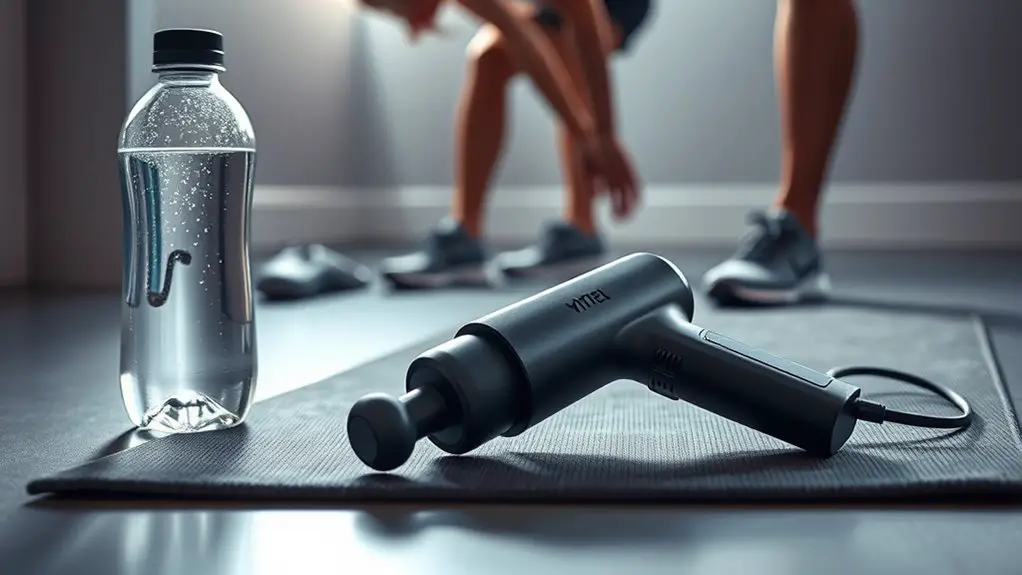
Before you grab your massage gun, it’s important to warm up your muscles to enhance effectiveness and prevent injury. Focus on the target muscle groups you plan to work on, ensuring they’re primed for relief. A good warm-up not only prepares your body but also maximizes the benefits of your massage therapy session.
Warm-Up Techniques
Getting your body ready for massage gun therapy can greatly enhance its effectiveness and your overall recovery. Start with dynamic stretching to increase blood flow and mobility in your muscles. Focus on movements that mimic your workout to activate the specific muscle groups you’ll be targeting. Next, incorporate foam rolling; this helps release tension and break up knots in your muscles. Spend a few minutes rolling out areas that feel tight or sore, allowing your body to soften before using the massage gun. By combining dynamic stretching and foam rolling, you’re not just preparing your body physically but also setting the stage for more effective massage therapy, leading to improved recovery and performance.
Target Muscle Groups
Targeting specific muscle groups with a massage gun can greatly enhance your recovery process. Focusing on areas like your quadriceps and hamstrings can lead to significant improvements in muscle soreness and flexibility. For a quadriceps release, position the gun on the front of your thighs, applying gentle pressure as you move slowly over the muscle. This helps alleviate tightness and improves blood flow.
For hamstring recovery, aim the device at the back of your thighs. Glide it along the length of the muscle, spending extra time on any knots or tight spots. Remember to adjust the speed and intensity based on your comfort level. By zeroing in on these key muscle groups, you’ll optimize your post-workout recovery and get back to training faster.
Identifying Key Muscle Groups to Target
While you might be enthusiastic to plunge into using a massage gun, it’s essential to know which muscle groups to focus on for ideal recovery. Start by identifying your target areas based on your workout. If you’ve been hitting the legs, focus on the quadriceps, hamstrings, and calves to alleviate muscle tension. For upper body workouts, target the shoulders, chest, and back.
Pay attention to any specific tight spots or soreness, as these indicate areas that need extra care. You might find that certain muscle groups require more attention than others, especially if you’ve increased your workout intensity.
Using the massage gun on these key muscle groups can promote blood flow, reduce soreness, and enhance recovery. By honing in on these target areas, you’ll maximize the benefits of your massage gun and get back to your routine feeling refreshed and ready.
Proper Technique for Using a Massage Gun

To effectively use a massage gun, start by holding the device at a 90-degree angle to the muscle group you’re working on. This positioning guarantees ideal penetration into the muscle fibers. Use a proper grip to maintain control; your hands should firmly wrap around the handle without excessive strain. Begin with low speed and gradually increase the intensity based on your comfort level.
Pressure control is vital—apply gentle pressure initially, then adjust as needed. Don’t press too hard; the goal is to relieve tension, not cause pain. Move the gun slowly along the muscle, pausing on any tight spots or knots to allow the device to work its magic. Remember, consistency is key, so take your time and enjoy the process. Following these techniques will maximize your post-workout relief and enhance your recovery.
Recommended Time Duration for Each Area
When using a massage gun, it’s important to spend the right amount of time on each muscle group for optimal recovery. The ideal duration can vary depending on muscle sensitivity and the specific area you’re targeting. Here’s a simple guide:
- Large Muscle Groups (e.g., quads, hamstrings): 1-2 minutes per area.
- Medium Muscle Groups (e.g., calves, shoulders): 30-60 seconds.
- Small Muscle Groups (e.g., forearms, wrists): 15-30 seconds.
- Trigger Points (knots): 30 seconds to 1 minute, focusing on these areas until you feel relief.
Pay attention to how your muscles respond; if they feel overly sensitive, you might want to reduce the time spent there. Adjusting the duration based on your body’s feedback will help you achieve the finest recovery results post-workout!
Frequency of Use for Optimal Recovery
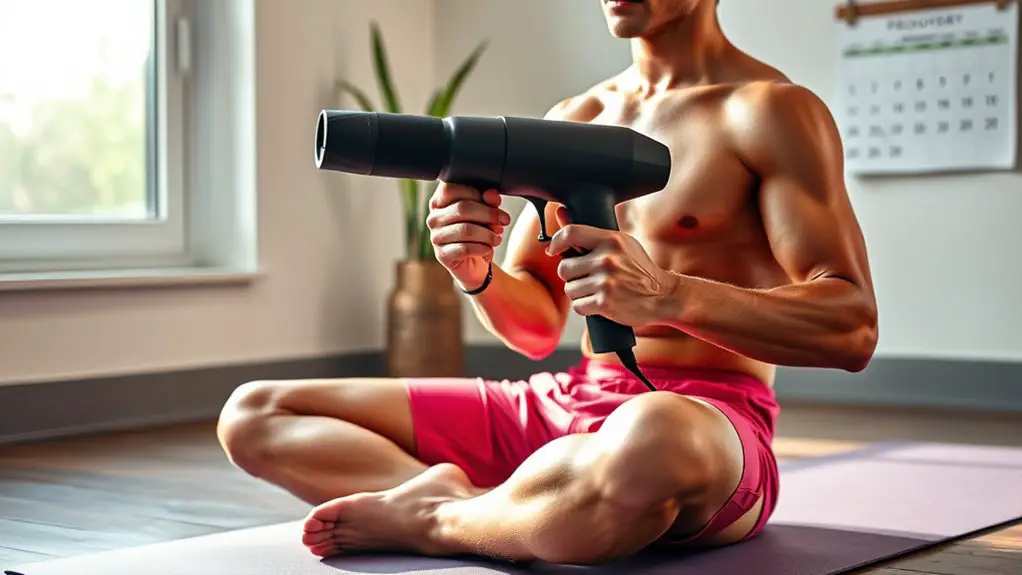
Finding the right frequency for using a massage gun can make a significant difference in your post-workout recovery. To achieve ideal frequency, aim to use the massage gun about 2 to 3 times per week for each muscle group. This allows your muscles to reap the benefits without overstimulation. If you’re recovering from an intense workout or feeling particularly sore, you can increase usage to every other day, adjusting based on your body’s response.
Pay attention to your recovery timeline; everyone’s body is different. Monitor how you feel after each session and adjust accordingly. Incorporating the massage gun into your routine can enhance blood flow, reduce muscle soreness, and speed up recovery times, but balance is key. Stick to consistent, moderate use, and you’ll likely find the sweet spot that works for you, leading to more effective recovery and better overall performance.
Safety Tips and Precautions
While incorporating a massage gun into your routine can enhance recovery, it’s important to prioritize safety to prevent injury. Here are some essential safety tips to keep in mind:
Incorporating a massage gun can boost recovery, but always prioritize safety to prevent injury.
- Proper Positioning: Confirm you’re in a comfortable position, allowing the massage gun to target the intended muscle group effectively.
- Avoid Bony Areas: Steer clear of joints, bones, and any areas with bruising or swelling to minimize the risk of injury.
- Start on Low Settings: Begin with a lower speed and intensity to assess your comfort level before increasing the pressure.
- Limit Duration: Use the massage gun on each muscle group for no more than 1-2 minutes to avoid overstimulation.
Incorporating Massage Guns Into Your Recovery Routine
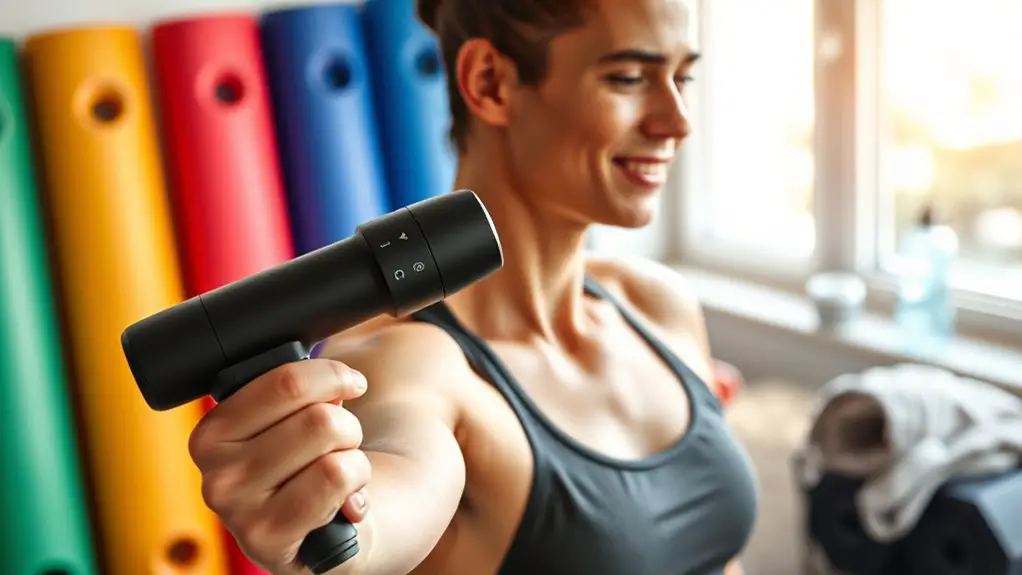
Incorporating a massage gun into your recovery routine can greatly enhance your post-workout relief, especially if you’re looking to alleviate muscle soreness and improve flexibility. To personalize your recovery, consider how often you work out and your specific muscle groups. Many users find that using a massage gun for just 10-15 minutes can considerably impact their recovery time.
Here’s a quick guide to help you get started:
| User Experience | Benefits |
|---|---|
| First-time user | Reduced muscle tightness |
| Regular user | Improved range of motion |
| Athlete | Quicker recovery post-events |
| Casual exerciser | Enhanced relaxation and comfort |
Frequently Asked Questions
Can Massage Guns Replace Traditional Stretching Techniques?
Can massage guns replace traditional stretching techniques? While they offer unique benefits, it’s crucial to evaluate a benefits comparison. Massage guns provide targeted relief and muscle recovery, acting as effective stretching alternatives. However, they shouldn’t fully replace traditional stretching, which enhances flexibility and promotes joint health. Instead, contemplate incorporating both methods into your routine for balanced muscle care. This way, you can enjoy the advantages of each approach for ideal results.
Are There Any Contraindications for Using a Massage Gun?
You might be surprised to learn that while massage guns can be beneficial, there are some contraindications. If you have certain health conditions, like osteoporosis or diabetes, or if you’re recovering from an injury, it’s best to consult a healthcare professional before using one. Using a massage gun improperly could exacerbate your condition. Always listen to your body and prioritize safety to guarantee your recovery and overall health are on track.
How Do I Clean My Massage Gun After Use?
Cleaning your massage gun after use is crucial for its longevity and hygiene. Start by unplugging it and removing any attachments. Use a damp cloth with mild soap for the body and wipe down the attachments thoroughly. Avoid soaking parts in water. For maintenance tips, make sure you check for any debris in the motor area and store it in a cool, dry place. Regular cleaning keeps your device in top shape and ready for use!
Can I Use a Massage Gun on My Back?
Oh sure, just blast your back with a massage gun like it’s a rock concert! But seriously, yes, you can use a massage gun on your back for muscle recovery. It’s a great pain relief technique that targets tight muscles and knots. Just be gentle, especially on sensitive areas. Start slowly, and let the gun work its magic. Your back will thank you, and you might just feel like a rock star afterward!
What Is the Best Speed Setting for Different Muscle Groups?
When you’re using a massage gun, the best speed setting varies by muscle group. For larger muscles like quads or hamstrings, try higher speeds for ideal settings to enhance muscle recovery. For smaller areas, like forearms or calves, lower speeds are more effective, allowing for a gentler approach. Experiment with different speeds to find what feels best for you, ensuring you promote recovery while avoiding discomfort. Your body will thank you for it!
